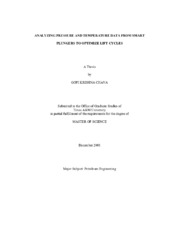| dc.description.abstract | The problem of liquid loading is common for all gas producing wells and should be
identified and solved for efficient gas production. Production engineers and operators
need to choose the best solution possible, one that is cost effective and also efficient in
doing the job. The plunger lift operation is a cost-effective solution to this liquid loading
problem and also is efficient in increasing the gas production. However, the current
understanding of plunger lift operation has used field experience and some previous
models that have restrictive assumptions which might not be applicable for all plunger lift
installations. This research proposes a new plunger lift model that overcomes some of the
limiting assumptions of earlier models by using additional data available in the form of
pressure and temperature from new technology like smart plunger. The model is based on
fundamental principles of mass conservation and pressure balance, and uses the smart
plunger data as input. The implementation of the model is carried out in user-friendly and
easily accessible software like Excel VBA (Visual Basic Applications). The model
predicts the plunger velocity, plunger position and annulus liquid level during an upward
travel of the plunger in an onshore gas well in East Texas. The results of model
implementation in VBA show the importance of fluid properties for the model, apart from indicating that the model is optimized for the given set of input data. The model
developed in this research considers only pressure drop due to gravitational effects, and
thus provides a scope for improvement in modeling the plunger lift dynamics by adding
frictional and acceleration components. This research also provides recommendations for
future work that can be carried out on plunger lift modeling using smart plungers. | en |


